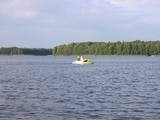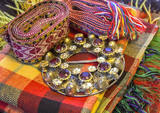| Нo | Название | Описание |
|---|---|---|
|
On 14 June 1991, this sign sculpted by Zezostrs Ķēde in memory of the repressions of 1941 and 1949 was unveiled in the garden of Pēterupe Church. |
||
|
Богатое заливами и полуостровами озеро Цириш (находится в Циришском природном парке) украшено несколькими островами, наибольший из которых - Упурсале укрыл в листве своих деревьев городище древних латгалов – Упуркалнс. У подножья обнаружены свидетельства древних поселений и найдены черепки посуды, каменное долото и другие предметы. На берегу восточной части острова устроена лодочная пристань лодок, а вокруг острова проложена благоустроенная природная тропа. |
||
|
Atrodas Inciema centrā. Piedāvā maltīti visām ēdienreizēm. Lielas porcijas, garšīgs ēdiens. Iecienīta tuvākas un plašākas apkaimes maltītes ieturēšanas vieta. Klāj galdus. |
||
|
Творческая ткацкая мастерская Мареты Петровичи, где рождаются яркие суйтские ткани, проводятся мастер-классы. Здесь можно приобрести сделанные на месте сувениры. Тем, кто хочеть принять участие в мастер-классах, следует записаться заранее. |
||
|
Город ветра, янтаря и музыкантов. В письменных источниках Лиепая впервые упоминается в 1253 году. Расцвет города как торгового порта начался уже в конце XVI века. Особенно знаменательным было правление Курземского герцога Екаба и Фридриха Казимира, когда через Лиепайский порт обеспечивался экспорт и импорт товаров из Литвы и Курземе. На месте засыпанной песком дюны реки Ливы был прорыт канал, создана пристань для кораблей. Рост города продолжался и в XVIII веке, после Северной войны и эпидемии чумы. Когда в 1795 году Курземе присоединили к Российской империи, Лиепайский порт стал одним из важнейших стремительно развивающихся западных портов империи. В конце XVIII – XIX вв. Лиепая одновременно становится излюбленным местом отдыха аристократии Санкт-Петербурга. В конце XIX века начались работы по возведению крепости и строительству военного порта. Город приобрел военно-стратегическое значение. Лиепая сильно пострадала во время Второй мировой войны. В 1967 году в Лиепае приостановил работу морской торговый порт, и город стал закрытым городом, где военный порт стал городом в городе. Сегодня военный порт и связанное с ним предложение является одним из востребованных продуктов туризма Латвии. |
||
|
Atrodas nepilnus 2 km austrumos no Aglonas, Aglonas – Dagdas ceļa malā. Tā ieceres autors ir Ēriks Delpers, kurš 2006. g. uzsāka vietas labiekārtošanu, izveidojot brīvdabas skulptūru dārzu un stādījumus. Kristus Karaļa kalns šobrīd atrodas izveides procesā, taču neskatoties uz to – objekts, ko ir vērts redzēt! |
||
|
Посетители кузницы могут наблюдать за работой кузнеца. Здесь можно заказать декоративные элементы, сделанные из металла, ограждения и другие изделия по индивидуальной договоренности. |
||
|
Rekovas dzirnavas ir unikāla vieta pašā austrumu pierobežā. “Pirmajā stāvā bija miltu malšana un otrajā stāvā apstrādāja vilnu. Dzirnavas pastāvēja līdz 1980.gadam. Vēlāk ēka nevienam nepiederēja, lietus ietekmē iebruka jumts un faktiski viss bija sadrupis. 2016.gadā zemnieku saimniecības “Kotiņi” saimniekam Aldim Ločmelim radās iespēja iegādāt ēku un saliekot galvas kopā, radās ideja, ka ēkā varētu būt vietējās produkcijas veikaliņš.” Majestātiskā trīsstāvu pamatīgu laukakmeņu mūra ēka, kas atrodas pašā Balvi-Viļaka ceļa malā, ir sākusi dzīvot jaunu dzīvi, kur ikvienam ir iespēja nobaudīt vietējo Latgales produktu garšu dažādā izpildījumā. Dzirnavu saimniece - viena no īstajām latvju saimniecēm Vija Kuļša uzņem tūristu grupas, kurām piedāvā nobaudīt vietējo Latgales produktu garšu dažādā izpildījumā. Ēdienkarte sastāv no piedāvājuma vegāniem, veģetāriešiem un klasiskās ēdienkartes. Viena no galvenajām ēdienu sastāvdaļām ir zs “Kotiņi’’ ražotā produkcija. Ir iespēja pieteikt un darboties arī Meistarklasēs. Tiek piedāvāvāts ēdiens no linsēklām, linu eļļa, dažādi salāti, ko var gatavot ar linu eļļu. Linsēklas izmanto pašu ceptā maizītē, sāļajā baltmaizē ar linsēklām. Linsēklas Rekovas dzirnavu ēdienkartē ir tikai viena no izejvielām, bet tieši tās ir centrālais varonis jaunajā Ziemeļlatgales kultūrvēsturiskā tūrisma piedāvājumā “Linu ceļš Ziemeļlatgalē”. |
||
|
Atrodas Rīgas – Ventspils autoceļa (A 10) 92. kilometrā. Piedāvā ēdināšanas pakalpojumus, klāj galdus un organizē citus pasākumus. |
||
|
Находится на правом берегу Даугавы. С разных мест Пиедруи на церковь открывается красивый вид. Первую деревянную церковь в Пиедруе построили по приказу князя Льва Сапеги в 1632-м году, но в 1759-м году она сгорела. Нынешний барочный каменный костел (возможно, автор проекта итальянский архитектор А. Пароко) с двумя башнями был построен в 1759-м году. Под 27-и метровым строением (высота башен) находятся подвальные помещения. На башнях находятся три колокола (самый большой с 1711-го года, средний – 1897-го года, малый – с 1619-го года). Самый большой колокол весит почти 0,4 тонны. В интерьере костела находятся многие значимые культурно-исторические памятники – центральный деревянный алтарь с картиной, изображающей Успение Пресвятой Девы Марии, три алтаря 18-го века, кафедра начала 19-го века, алтарь Св. Антона, фреска с изображением Св. Троицы, церковная утварь с 17-го века и др. К костелу прилегает обширный сад с каменной оградой и каменными каплицами. В саду находятся могилы настоятелей Казимира Конвалевского и Бронеслава Стефановича. Последний сыграл большую роль в восстановлении костела после Первой мировой войны. Пиедруйская община начала образовываться в первой половине 17-го века. |
||
|
Трактир Raudnaela расположен на обочине шоссе Пярну-Тарту, на месте бывшего трактира Raudna (1700 г.) – в 15 минутах езды от Вильянди. Гости могут насладиться вкусной домашней едой или же заказать тематический ужин. |
||
|
Находится в 1,2 км к югу от центра Гипки, на другой стороне дороги Юрмала – Колка (P 131). Трудно поверить, что эта церковь, выстроенная из булыжников, построена совсем недавно – после 1992 года, поскольку предыдущая сгорела в советское время – в 1979 г. Иронично обстоятельство, что в башне церкви после Второй мировой войны находился наблюдательный пожарный пост Дундагского лесничества. Во время пожара погиб великолепный алтарь и орган, но алтарную картину „Христос на кресте” удалось спасти. Теперь храм снова служит своему основному назначению. |
||
|
Ein der ethnografischen Dörfer in Dzūkija mit Holzgebäuden und Kruzifix. |
||
|
Яунциемс и ранее был небольшим поселением – сегодня здесь обжиты всего несколько домов. Рядом с деревней на правом берегу реки Ирбе находятся зоны отдыха. Яунциемс и Сикрагс объединяет «просека» бывшей узкоколейной железной дороги, где через речку Киканс построен пешеходный и велосипедный мост. |
||
|
Atrodas Tērvetē, Dobeles – Elejas ceļa malā, 0,2 km dienvidrietumos no Tērvetes pilskalna. Ar mežu apaugušais paugurs ir sena apmetnes vieta, kas bijusi apdzīvota jau 1. g.t. pr. Kr. Teika stāsta, ka kalnā bijis klosteris, kura mūki pēc klusēšanas pārkāpuma saulgriežu laikā kopā ar visu celtni nogrimuši kalna dzīlēs. |
||
|
72 types of wild rhododendrons with 193 different species
This is the only specialised rhododendron nursery in the Baltic States. Specialists there work on different kinds of rhododendrons, seeking to produce decorative and winter-resistant types of the flower. The nursery also sells plants. In the facility’s pine forest, which covers 11.8 hectares, you can see a large collection of rhododendrons from all over the world.
There are 64 winter-resistant types of rhododendrons at “Babīte,” including “Alma Mater,” “Academia Scientiarum,” “Emeritus,” “Eduards Smiļģis,” “Dita Krenberga,” and others (these were developed by Rihards Kondratovičs). All of these are appropriate for Northern Europe.
|
||
|
A very impressive ensemble that is in terrible shape. The estate dates back to the 18th and 19th century, with the castle being built in the early 19th century. Half a century later it was rebuilt in the Neo-Gothic style with symmetrical towers and bricks in the cornices. The estate belonged to the Manteufel-Stzege dynasty. The vestibule, stairwell and second floor hall still have ornamental ceiling paintings, but visitors are not allowed to enter the building, so they cannot be seen. Valuable interior design elements include a fireplace from the early 19th century that is decorated with marble elements. After the expropriation of the castle in 1920 and until 1951, the building housed a forestry school and then an agricultural crafts school. Opposite the castle was the stable of the state that was built in the style of Classicism with a pediment and mighty columns. Built in the early 19th century, the stable is no longer used and can only be viewed from the outside. A very much overgrown park surrounds the complex, and the hillock is the grave of one of the baron’s dogs.
|
||
|
Находится в срубе, крытом деревянной дранкой, на расстоянии до одного километра от Гулбенской железнодорожной станции. Предлагают сытные латышские блюда. Латышская кухня: Тонкие и картофельные блины, селедка с творогом, жаркое, жареная треска, слойка из черного хлеба. |
||
|
Ресторан «Розалия» расположен в гостинице "Kolonna Hotel Rеzekne", который находится в центре города Резекне, на берегу реки Резекне. С летней террасы открывается красивый вид на набережную - променад реки Резекне. Гостям предлагаются блюда, приготовленные по старинным латгальским рецептам. Используются местные продукты. Латышская кухня: Жареная селедка, суп из кислой капусты, гульбешники, блюда из свинины и картофеля (бульбы), клёцки, асушки со сметаной и шмаковка. Особое блюдо: Картофельные клёцки с крапивным маслом и валиками из мяса. |
||
|
Кафе Roomassaare находится неподалеку от Курессааре ‒ отсюда открывается живописный вид на яхтенную пристань Roomassaare. В летний сезон в кафе преимущественно готовят блюда из местных продуктов, предлагая и жителям острова, и туристам простое и чистое сочетание местных вкусов. Без рыбы не обойтись! |
||


















